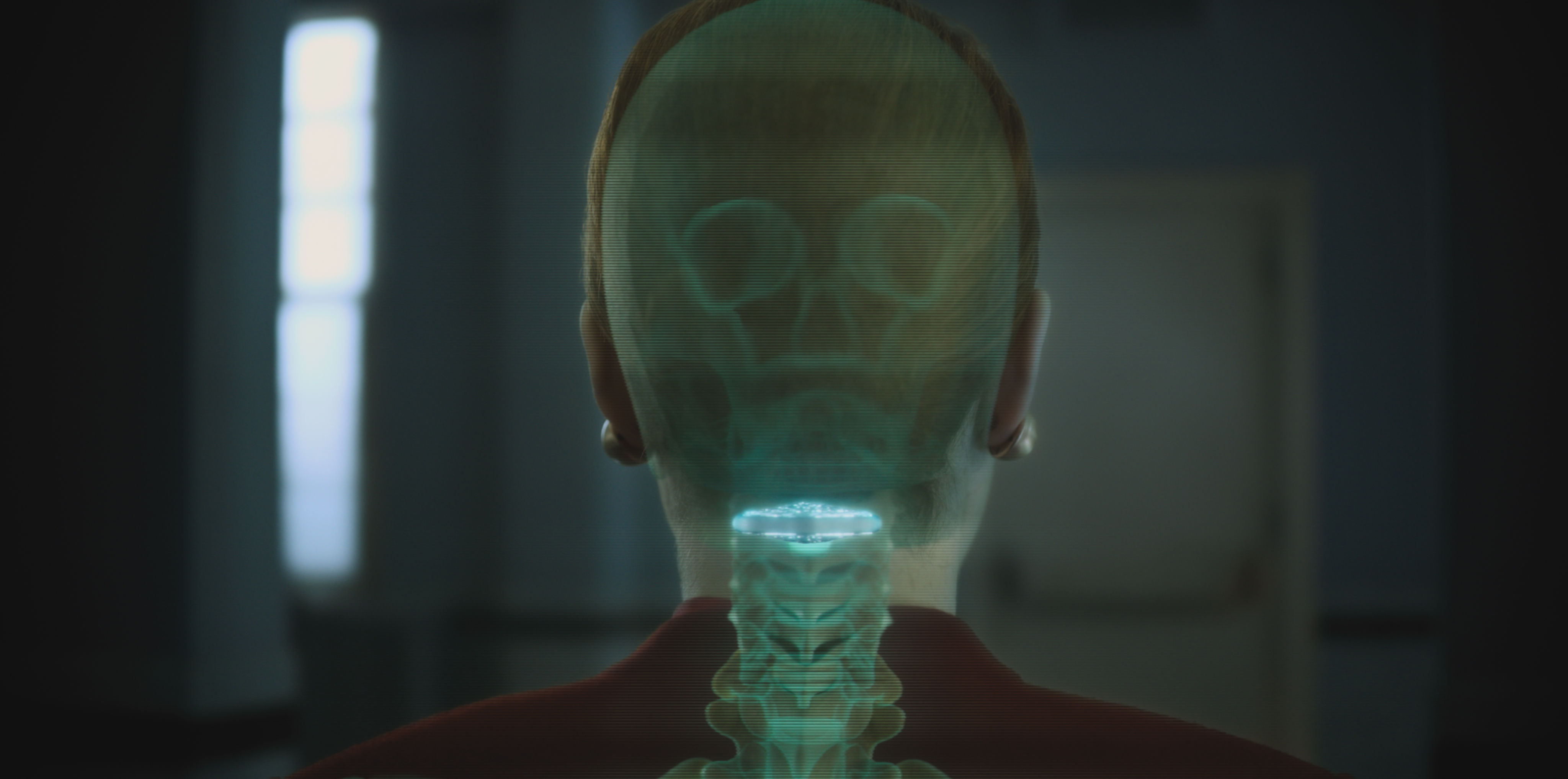Create a free profile to get unlimited access to exclusive videos, sweepstakes, and more!
How to build a body from scratch, Altered Carbon-style

The world of Netflix's Altered Carbon is one where consciousness is no longer tethered to the physical body. It can be, and regularly is, uploaded into "cortical stacks," which are implanted at the base of the neck. In the event of death, a person’s consciousness can be reloaded into a new body, known as a "sleeve." For those less fortunate, like protagonist Takeshi Kovacs, that might mean receiving a body that’s not your own. In one particularly existential example from the series’ first episode, it might even mean a young child being uploaded into the body of an adult.
For those with means, however, the mind can be placed into a swiftly made, identical clone, allowing them to return to their lives with little interruption. We've covered what it might take to create a digital copy of a person’s mind before (spoiler: it wouldn’t be easy), but Altered Carbon's techno-immortality requires a second piece: the swift creation of replacement bodies.
One of the major hurdles that has kept real-world cloning from being the game changer everyone suspected it might be after the birth of Dolly, the first successfully cloned mammal, is the relatively slow development of human bodies. If you wanted to clone a 50-year-old human and get them back to the same stage of development, it would take you 50 years. That's a little too slow to make use of in the same way science fiction does.
We don't have the means to artificially age a body at a rapid pace, but what if we were able to shortcut these limitations — to put it plainly, what would it take to build an adult body from scratch?
BONES
If you want to build a person from scratch, you must first make the universe. Carl Sagan said something like that, I think. Just after that, though, you’ll need a skeleton. Without bones, you’ll be left with little more than a Cronenbergian nightmare, cool in its own way, but not what we’re shooting for.
Today, if you have trouble with your bones, your options are limited. The first option, and in most cases the best one, is to let the bone heal itself. Your body is pretty resilient and capable of repairing most day-to-day injuries, even the ones accompanied by a sickening crack. If the injury is really bad, things get a little more medieval. Surgeons might use a series of metal plates and screws to hold your bones in place and give them time for your body’s healing processes to do their work. But those solutions only work for relatively minor injuries where the bone tissue is at least moderately intact.
When it comes to bone replacements, things are a little tougher.
Again, we can return to metal. Like the Wolverine, you might have part of your skeleton replaced or covered over with metal. This might be sufficient in specific cases, but it all feels a little crude.
Ramille Shah, Ph.D., headed a team out of Northwestern's McCormick School of Engineering to create a new material capable of instigating rapid bone regeneration. The team used 3D printers (the invention that never stops giving) and a mixture of 90 percent hydroxyapatite, a natural element of human bones, and 10 percent medical polymer to build bone constructs.
The result is a bit of artificial bone modeled in whatever shape the patient needs. It is porous, allowing for blood vessels and other tissues to easily integrate. The elastibone (perhaps the worst superhero name, trademark pending) stimulates bone regeneration and degrades over time. The intent is for the artificial structure to dissipate, leaving actual bone in its place. A technology like this would go a long way to repairing complex bone defects in all manner of patients, but is particularly promising in pediatrics, where the patients are still growing.
But, in order to truly build a bone from scratch, we’ll need something even better. That’s where Nina Tandon and EpiBone come in.
This technology would work by taking a sample of fatty tissue, something readily available if your plan is to build a copy of an existing person, and use it to extract stem cells. Those cells would then be applied to a 3D printed scaffold of a cow’s bone which has been scrubbed of all its living cells. Those undifferentiated stem cells would then be placed into a bioreactor (something which sounds made up but is very real) and coaxed into growing into a fully formed bone in just a few weeks. Given enough bioreactors, and enough cows (pour one out for our fallen bovine brethren) you could feasibly grow an entire skeleton in the time it takes for you to finally fold the laundry that’s been sitting in the corner of your room.
Now that you’ve got a skeleton, you’re going to need some…
ORGANS
For a long time, there weren't many ways to get a new organ if you needed one. The most commonly used method (we hope) was to get your name on a list and wait for a donor. The unfortunate reality of organ donation is that there are more people who need organs than there are organs available. Even when an organ does become available, the odds are against you that they’ll match your body’s preferences, and even if you get a match, there’s always the threat of rejection.
Organ transplants are a veritable miracle procedure and, while we sometimes take them for granted, they are evidence of our living in truly wizardly times in medical science. But science is never content with the status quo and humanity is forever wondering if we can further laugh in the face of nature. The preferred solution would be to develop a way to craft bespoke organs, made from the recipients' own cells.
Growing cells in a petri dish is old hat. We’ve been doing that for longer than many of us have been alive. The trouble is, you can take a heart cell and induce it to multiply in a dish, but all you end up with is a dish-shaped collection of heart cells. That might be good for studying cellular biology, not so good for pumping blood through a person.
A collection of cells does not an organ make. You need something more — a scaffold. Each of your organs is a complex collection of various cell types clinging to a protein structure. You can think of that structure as the framing around which the rest of a house is built. Without it, you've got little more than some insulation and drywall tossed into a haphazard stack. You need that scaffold.
There are hopes that one day we’ll be able to build them via (drum roll please) 3D printing, but we’re not there yet. The level of minute detail involved is beyond our current ability. So, we have to borrow from nature.
Scientists are able to take an existing organ and strip it of its surface cells by pumping detergent through it (good for removing pesky stains and unwanted biological material). What’s left is a ghostly protein structure ready for seeding.
All that's left is to take tissue samples from the recipient and seed them onto the structure, pop it into one of those handy bioreactors, and let the cells get to work. Eventually, you’ll end up with an organ made of the patient’s own tissues. Current tests are pretty impressive, but we’re still a ways off from having a functioning process. The number of different tissue types involved in complex organs is a barrier and the complexity of small structures like circulatory vessels is another. Still, the technology is promising and would not only allow us to build any and all organs in record time, it would solve the organ transplant shortage and save countless lives.
So, now you’ve got a rigid skeleton filled with juicy oozing organs. Your neighbors are starting to wonder about the smell coming from your garage and you’re grateful this abominable creature is not yet sentient because it would very likely go running for the hills. At least it would if it had…
MUSCLES
Look, we all know it’s been a while since you’ve been to the gym. You bought a membership for the new year and you went a few times. You really meant well but life happened and, somehow, it all got away from you. We get it. It happens to the best of us.
While you might not have the muscle mass you wish you had, you still have quite a lot. The average person’s body is comprised of somewhere between 35 and 40 percent muscle, give or take. That’s a lot. Even after all of your efforts with bioreactors, you’ve only managed to make 60 percent of a person. It’s nothing to be scoffed at, but you aren’t done yet.
In order to complete next steps, you’re going to need more tissue samples and a few friends from Duke University.
Using human cells that were no longer stem cells but not yet muscle cells, Nenad Bursac and Lauran Madden, an associate professor of biomedical engineering and a postdoctoral researcher, respectively, were able to successfully create functioning muscle tissues in a lab.
They grew the tissue samples and, using a 3D scaffold and a nutritive gel, ended up with working muscle fibers. These bundles of muscle fibers included receptors capable of taking in external stimuli and contracted when acted on by electricity.
For their part, the intent is not to build novel muscular structures, but to test the efficacy of drugs to treat diseases. According to Bursac, drug tests in the laboratory matched results seen in living patients. Those patients with muscular ailments could provide a tissue sample, that sample could then be grown into fiber bundles and used to test various drug treatments, ex vivo, to find a workable treatment without all the trial and error usually required.
Thanks to Bursac and the team at Duke, you’ve now built almost all of Takeshi Kovacs. He’s twitching and moving around on the table. He might be screaming a little, thanks to those vat-grown lungs and he’s still oozing a bit. Most of all, he’s embarrassed by his nakedness. A lot’s changed in the intervening centuries, but not the need for…
SKIN
You’ve got your terrible Frankensteinian gift all put together, all that’s left is the wrapping. Here, too, is an area we’re moderately familiar with. When a patient loses skin through injury, a graft can be taken from elsewhere and used to replace the damaged tissue. It gets the job done, some skin is better than no skin of course, but there’s still room for improvement.
More recently, bioengineers have had some success in growing sheets of epithelial tissue for implantation but they lacked oil and sweat glands. Again, close, but not quite. Until…
A study undertaken at the RIKEN Center for Developmental Biology, led by Takashi Tsuji took cells from the gums of mice and used chemicals to revert them to a stem-cell-like state. The cells were used to grow complex skin tissues.
Once the tissues were ready, they were transplanted onto living mice and were found to develop normally. Not only did those tissues function as a protective barrier, the primary function of skin, but they also succeeded in developing hair follicles and sweat glands. Even more importantly, they successfully integrated with surrounding tissue systems like muscle groups and nerves.
There are, of course, other tissue types we’ve not covered, each of them important to the successful functioning of a body, but if these emerging technologies are any indication, we’re well on our way in those areas as well.
So, you’ve done it. You’ve made a full-grown human from scratch in months rather than decades. All that’s left is to upload a mind and you’re well on your way to cyberpunk chicanery. Go forth, Kovacs, we're rooting for you. And don’t mess up this body, please. It was really hard to make. Thanks.


























